Multi-focal intraocular lens, and methods for making and using same
a multi-focal, intraocular lens technology, applied in intraocular lenses, medical science, prosthesis, etc., can solve the problems of reducing the ability to focus for the same muscle action, affecting the optical focusing system of the eye, and the efficiency of the ciliary body-zonules-lens complex becoming less efficient at accommodating the focus of these rays, so as to achieve the effect of restoring the focus mechanism and not affecting the field of vision
- Summary
- Abstract
- Description
- Claims
- Application Information
AI Technical Summary
Benefits of technology
Problems solved by technology
Method used
Image
Examples
examples
[0134] All examples were modeled on the Zemax Version 10.0 optical design program, SE edition, from Focus Software, Inc.
[0135] The human eye was first modeled as a typical or schematic adult human emmetrope, as described in the Optical Society of America Handbook. Each of the models described below is for a posterior chamber IOL design. The following assumptions were made for the human eye for the purposes of the calculations. The model was assumed to have spherical surfaces only (whereas the real cornea and lens are actually aspherics). Each structure of the schematic human eye was assumed to be made of a material having a uniform or homogenous index (whereas in the real human eye, the index of refraction may vary somewhat through each structure of the eye). The model also assumed that the capsular bag walls were very thin and parallel, i.e., non-existent. The lens was assumed to have symmetric radius, i.e., spherical. The pr was assumed to be 10 meters. Three wavelengths with equ...
PUM
 Login to View More
Login to View More Abstract
Description
Claims
Application Information
 Login to View More
Login to View More - R&D
- Intellectual Property
- Life Sciences
- Materials
- Tech Scout
- Unparalleled Data Quality
- Higher Quality Content
- 60% Fewer Hallucinations
Browse by: Latest US Patents, China's latest patents, Technical Efficacy Thesaurus, Application Domain, Technology Topic, Popular Technical Reports.
© 2025 PatSnap. All rights reserved.Legal|Privacy policy|Modern Slavery Act Transparency Statement|Sitemap|About US| Contact US: help@patsnap.com



